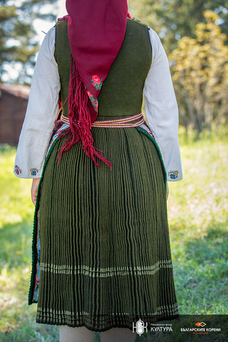Festive green skirt from the village of Eleshnitsa from the first half of the twentieth century
- Грозделина Георгиева-Саватинова
- Jul 8, 2021
- 3 min read
Updated: Nov 4, 2021
This festive attire is typical for married women who so prepared to go to the megdan, the round dance, go to an engagement or wedding, etc.
In the photo, the woman is wearing a white shirt (koshulya) made of cast-woven cotton cloth with a rich embroidered decoration "zapeski" of roses on the sleeves and embroidered with red thread "triple stitch" on the armpit. Compliand to the length of the skirt and the shirt is shortened. The top has a dark green finely pleated foustan made of fine wool fabric. It has a cut of a dress with a top attached to the torso and a finely pleated skirt sewn to it, decorated with belts of 2-3 ribbons.

After the 1920s, the bosom was cut deeper and the decorated embroidered shirt was shown below. The oval or square bosom is trimmed with rich hand-embroidered purl ornaments and black braid.
A double-breasted apron called "futa" - black with vertical stripes, filled with small floral ornaments, decorated on the sides with so-called "zubci". It is tied with fabrics weave on a loom without a hill string for an apron, called „lashnitsi”. They act as a gridle or belt from older clothing, where you can fasten your embroidery veil. This „futa”, as well as the foustan of a different color from scarlet, were worn until the middle of the XX by married women and women who have given a birth as the bosom decorated with tinsel and the fringed fringes on the sides emphasize the festive look of the dress and show that the woman is wealthy.

Veiled with a „sindzhirliya" with loose ends in dark red and a chain of roses (hence the name of the veil), put on solemn occasions.
To compensate for the short shirt and skirt, socks become taller - black or white, up to above the knee. They are covered with knitted wool socks. She is wearing shoes with side fastening, as urban women wear.

The shirt of women of fruitiful age necessarily has a red color - a symbol of blood and life, while the embroidery in adults acquires darker colors. The young bride gives her future mother-in-law a richly embroidered shirt if she is relatively young, but if she is already an old woman, the shirt is poorer in terms of ornamentation. The woman makes her own dress - which is sometimes lower, and in other cases turns into an outer garment. Nevertheless, it must be related to the idea of protecting the woman from "uradisvane." The popular belief is strong and it is no coincidence that the clothing has reflected these centuries of knowledge about storage.
Due to its comfort and feminine look, the foustan became a favorite garment in the whole Razlog region from the beginning to the middle of the XX century. This is the typical transitional urban clothing in the area, with small differences in patterns and a wide variety of color preferences.
Kristina Karpacheva from Razlog put on the costume.
This costume is of the genius from Eleshnitsa.
The project "Study of the specifics and richness of national costumes from the Razlog region in the light of cultural diversity" is realized with the financial support of the National Culture Fund under the program "Cultural Heritage".
In fulfillment of the goals of the project we present some of the most beautiful traditional costumes, typical for the Razlog valley in the last 2 centuries.
We offer our sincere thanks to our hosts from the Historical Museum - Razlog, and to all local people who helped with the realization.
Special thanks to all participants and team members who took their time and with useful information, knowledge and valuable advice made possible the work on the project.
A reverence to the girls and boys from the town of Razlog, who stood in front of our camera and with their enthusiasm, youth and beauty revived for a new life the most beautiful costumes from old Mehomiya.

















תגובות